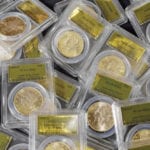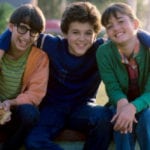 Miscellaneous
Miscellaneous  Miscellaneous
Miscellaneous  Gaming
Gaming 10 Funny Tutorials in Games
 History
History 10 Fascinating Little-Known Events in Mexican History
 Facts
Facts 10 Things You May Not Know about the Statue of Liberty
 Movies and TV
Movies and TV 10 Movie Adaptions That Brought Popular Songs to Life
 Health
Health 10 Miraculous Advances Toward Curing Incurable Diseases
 Miscellaneous
Miscellaneous 10 Undeniable Signs That People’s Views of Mushrooms Are Changing
 Animals
Animals 10 Strange Attempts to Smuggle Animals
 Travel
Travel 10 Natural Rock Formations That Will Make You Do a Double Take
 Movies and TV
Movies and TV 10 Actors Hidden in Your Favorite Movies
 Miscellaneous
Miscellaneous 10 Interesting Things Manufacturers Stopped Making and Why
 Gaming
Gaming 10 Funny Tutorials in Games
 History
History 10 Fascinating Little-Known Events in Mexican History
Who's Behind Listverse?

Jamie Frater
Head Editor
Jamie founded Listverse due to an insatiable desire to share fascinating, obscure, and bizarre facts. He has been a guest speaker on numerous national radio and television stations and is a five time published author.
More About Us Facts
Facts 10 Things You May Not Know about the Statue of Liberty
 Movies and TV
Movies and TV 10 Movie Adaptions That Brought Popular Songs to Life
 Health
Health 10 Miraculous Advances Toward Curing Incurable Diseases
 Miscellaneous
Miscellaneous 10 Undeniable Signs That People’s Views of Mushrooms Are Changing
 Animals
Animals 10 Strange Attempts to Smuggle Animals
 Travel
Travel 10 Natural Rock Formations That Will Make You Do a Double Take
 Movies and TV
Movies and TV 10 Actors Hidden in Your Favorite Movies
10 Ordinary Locations With Horrifying Secrets
Haunted houses, crumbling Transylvanian castles, abandoned lunatic asylums . . . there are plenty of places in this world we instinctively know are utterly terrifying. But not all buildings wear their true colors on their sleeves. Every now and then, some place that seems normal and sane will turn out to secretly be a horror pit of screaming nightmares.
SEE ALSO: 10 Real Places Straight Out Of A Nightmare
10The Finnish Museum Infested With Gigantic Spiders

A grand old building in the heart of Helsinki, Finland’s Natural History Museum is one of the capital’s premier tourist attractions. It’s also a place where no arachnophobe should ever set foot. The building is home to a gigantic colony of extremely venomous, near-immortal super-spiders.
Known as the Chilean recluse spider, the creatures are normally only found in South America. Unfortunately for Finland, some eggs made their way into a shipment of wood chips the museum ordered in the 1960s. They hatched, and the spiders escaped into the museum. By 1970, the place was overrun with them. In 2016, they’re not only still there—there are more of them than ever.
The trouble is that the Chilean recluse spider is almost indestructible. Females have been known to survive without food or water for 755 days. They can deal with extreme temperature changes and can lay up to 2,250 eggs in a lifetime. As an added bit of freaky detail, they can grow to up to 10 centimeters (4 in), and their bite will leave you howling in agony (if it doesn’t kill you outright).
On the plus side, the recluse spider gets its name by hiding away from humans. In the 50-plus years the museum has been infested, only one bite has ever been recorded. This is extremely good news, as the museum is built above a series of tunnels linking many buildings in Helsinki. The BBC has speculated that it’s only a matter of time before the colony expands outward into other parts of the city center . . . if it hasn’t done so already.
9The American Dam Stuffed With Corpses

You’ve probably heard the rumors about dead workmen entombed inside the Hoover Dam. Those stories are exactly that: stories that have no basis in fact. At least, not where the Hoover Dam is concerned. Go visit the Fort Peck Dam in Montana, and you’ll be looking at a gigantic tomb stuffed full of dead guys.
On September 22, 1938, the dam was the site of an infamous local disaster. The night before, workmen had noticed the structure was starting to bow, shifting 2 meters (6 ft) from its original position. At 1:15 PM the next day, just as the district engineer arrived to inspect the problem, the whole thing gave way with a terrible roar. It’s estimated that 4 billion liters (1 billion gal) of water, mud, and concrete suddenly spewed out into the Missouri River, destroying everything in its path. Eight men who stood in the way disappeared into the sludge. Only two bodies were ever found.
While plenty of dams have similar disasters in their history, what happened next makes Fort Peck Dam eerie. The sludge was recycled back into the dam’s construction, along with the six bodies lost within it. To this day, the corpses of the six drowned men remain part of the dam itself, like gruesome Easter eggs hidden in the concrete.
8The London Picnic Spots Built Over Gruesome Mass Graves

If you’re ever in London for the summer, one of the best things you can do is grab a drink and head to one of the city’s many picnic spots to relax with the locals. Provided, that is, that you can ignore the screaming mess of horror hidden just below your feet. A 2014 study of London’s plague pits found that dozens of modern picnic spots were built over the site of centuries-old mass graves.
Like most of Europe, London got hit hard by the Black Death. In the 1665–1666 outbreak alone, around 15 percent of the city’s population died in agony. The infected would come down with a fever and sharp pains that would build to vomiting and delirium. Huge, painful buboes would swell up under the skin, full of foul-smelling liquid. Within a week, some 60 percent of victims would be dead.
With so many corpses piling up, authorities did the only rational thing. They interred the bodies in mass graves, the locations of which were often forgotten within a few short years. Back in 1598, one survey suggested as many as 150,000 plague corpses were already under the city, with more to come over the following century. If you ever find yourself enjoying the sunshine in Green Park, Shephard’s Bush Green, Golden Square in Soho, or any of dozens of other popular picnic sites identified by the study, spare a thought for the unknown dead beneath your feet.
7Sri Lanka’s Killing Fields Hotel

From the outside, Lagoon’s Edge in Sri Lanka looks like any normal, tropical hotel. It features large, rustic rooms, a view onto a pristine beach, and a Facebook page that boasts, “Enjoy a soothing holiday and the cool breeze of Nanthikadal lagoon.”
If you’re already rushing to book your next vacation there, you might want to hold back a second. While Lagoon’s Edge may be devoid of gigantic Chilean spiders, its location is far from idyllic. It was built on top of the site of the Tamil Tigers’ last stand at the end of Sri Lanka’s long and bloody civil war. In the final government push to eliminate the insurgent group, so many civilians died that the area is now known as Sri Lanka’s killing fields.
The scale of the murders that took place here is staggering. In the final weeks of the war, the UN estimated that 40,000 people died, many of them Tamil civilians used by the Tigers as human shields. When government forces moved in, many of the surviving civilians were raped, tortured, and executed. The scale of war crimes committed in the area was so great that both the UN and one of Sri Lanka’s top judges have urged for a criminal tribunal like that for Rwanda and the former Yugoslavia.
Perhaps the most shocking part of all this is how quickly the hotel opened over this bloodstained battlefield. The mass killings took place in 2009. Lagoon’s Edge opened for business in 2012.
6The Indian Temple Crawling With Giant Rats

Set in the blistering depths of Rajasthan’s Thar Desert, the Karni Mata Temple in India at first looks like any other grand old place of Hindu worship. Built in the 1400s, it’s the sort of place stoned backpackers go to in search of enlightenment. Or so you’d think. Look a little closer, though, and it’s clear the temple has a freaky secret. The whole place is crawling with gigantic black rats.
Known as “little children” by the worshipers, the rats are said to be the reincarnated caste of a Hindu deity. In practice, this simply means these swarming hell monsters are given free rein to overrun every single inch of the temple. According to estimates, there are as many as 20,000 black rats living freely in the grounds. Now might be a good time to point out that India has one of the world’s highest death rates from rabies, plus occasional outbreaks of the bubonic plague.
Creepy as most of us would probably find a rat-infested temple, locals consider the creatures lucky. It’s not uncommon for people to eat food already nibbled by the rats in the belief that it’ll bring good fortune.
5The New York Streets Built Over Dead African Slaves

Although American slavery is today largely associated with the South, it’s worth remembering that plenty of Northern states were initially okay with owning slaves. The city of New York was no exception. Back when it was still known as New Amsterdam, plenty of African slaves were brought and ultimately worked to death. Walk along Chambers Street in lower Manhattan, and you’re walking over the bones of around 20,000 of those former slaves.
At the time, the street marked the edges of the city. Since slaves could not be buried in NYC itself, their bodies were hauled out just beyond the city limits and interred haphazardly in a slave burial ground. As time went by, the city grew, and no one thought anything of building a street over a bunch of dead slaves. In fact, so few records were kept that it was only when 419 bodies were dug up in the 1990s that New Yorkers realized how many enslaved Africans had died and been buried there.
Since those days, a monument has been built to all those forgotten dead. But most will never be excavated. For the foreseeable future, all the buildings along Chambers Street and beyond will continue to stand over one of America’s most shameful mass graves.
4The British Building That’s The Most Contaminated In Western Europe

When you hear the words “massive European radiation disaster,” which country do you think of? We’re betting nearly 100 percent of you just said “Ukraine.” It makes sense: The Chernobyl disaster remains the worst nuclear accident on record. However, there is one other country you could have plugged for that might surprise you. The United Kingdom is home to the most hazardous, radiation-soaked building in the whole of Western Europe.
Sellafield was the UK government’s first foray into nuclear energy. It was also one of the most badly handled ventures in history. When Britain’s coal miners went on strike in the 1970s, the government overworked Sellafield to stave off an energy crisis. Rather stupidly, this meant leaving no time for proper disposal or cataloguing of potentially dangerous materials. Instead, they were all just chucked into a pool in one of two rooms: Building B30 and B38. These rooms are now considered some of the most dangerous in the world.
Although Sellafield looks like a normal plant from outside, New Scientist has called it the “world’s riskiest nuclear waste site” and claimed it is in constant danger of explosions and radiation accidents. The cleanup operation required to make it safe was started in 2009. It is not expected to end until 2120.
3The Hospital That Nursed Two German Dictators

Sometimes, places are haunted not by anything that specifically happened there but by who they are associated with. Such is the case with the abandoned Beelitz Heilstatten hospital in Germany. Although from the outside, the building looks like any derelict site, the hospital has a dubious historical distinction. It was here that Hitler was nursed back to health following a British mustard gas attack in World War I.
To be fair, Hitler spent time in plenty of places before making his famous transition from failed artist to murderous villain. If we were to claim all of them had horrifying secrets, we could’ve just filled this article with 10 buildings from Berlin and schlepped off to an early lunch. What makes the Beelitz Heilstatten special isn’t just that it saved Hitler’s sight (bad move). It’s that the staff seemed to go out of their way to collect German dictators. Many years after Hitler’s reign was over, another Germanic despot was treated here: the East German Communist stooge Erich Honecker.
Honecker was the man in charge of the GDR, the man responsible for both the Berlin Wall and the infamous Stasi. After ordinary Germans got fed up with living apart and tore his wall down, he retired to Beelitz Heilstatten to recuperate. If we could only now find evidence the Kaiser was also treated there, that would be a German despot hat trick.
2The Disney Rides With Creepy Secrets

Disneyland bills itself as the happiest place on Earth. Deep down, most of us know this is marketing propaganda. Workers are known to refer to the place as mousewitz (a cheeky, non-PC reference to Auschwitz). But some people apparently buy the hype, in the creepiest way possible. According to former employees, Disneyland has long had a terrifying problem with bereaved people dumping their loved ones’ ashes onto the rides.
That’s right: Those kids running around having the time of their lives might be running through the remains of dead people. In 2007, a woman was caught sprinkling what was assumed to be human ashes into water at the Pirates of the Caribbean ride (and accidentally triggering a security alert when park officials thought it was a chemical attack). Others have been caught doing the same at the Haunted Mansion, so the ride now very much lives up to its name.
We should mention here that Disney denies this is a problem. But many former employees who spoke with the LA Times after the 2007 incident claimed such scattering of ashes was creepily routine.
1The Innocuous Houses Used By Serial Killers
One of the slightly ghoulish aspects about catching a serial killer is that you then have to decide what to do with their property. While the press and public are caught up in the trial, local officials or landlords have to decide what happens to their former homes.
In most cases, this is easy. Many serial killers do their actual killing away from home, so reselling the house isn’t too ethically dubious. In a lot of the cases where people were tortured and murdered on the property, the owners opt for demolition—as happened with the former home of British serial killers Fred and Rose West. But occasionally, the landlord decides to just keep renting it out. That’s how you can wind up living in an innocuous-seeming home that is really a den of unimaginable horrors.
In 2015, the London flat where serial killer Dennis Nilsen murdered around a dozen young men went up on the market. It’s far from the only such property available. The former home of the “crossbow cannibal” Stephen Griffiths is currently being lived in by a student, whose only request was that the landlord replace the kitchen where he cooked his victims. In what may well be a piece of accidental satire, the current owner of Jeffrey Dahmer’s former home is specifically offering it for rent during the 2016 GOP convention in Ohio.
In short, there are a disturbingly high number of homes out there where people met gruesome, horrifying ends. And they can be yours to live in. It’s a weird world, all right.








